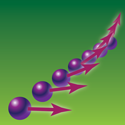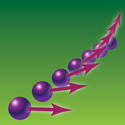Muons put a new spin on ice
Rare-earth pyrochlores are materials of the type , where is a rare-earth element and is a transition metal. At low temperatures, pyrochlores order magnetically in ways determined largely by the choice of rare-earth ion. For example, when cooled, enters into a short-range ordered phase called spin ice, in which the arrangements of the magnetic moments on the transition metal ions are analogous to those of protons in water ice.
An open question in the spin ice phase of is whether the spins are fully dynamic or contain a static component. To address this problem, Sean Giblin and colleagues at the ISIS facility at the Rutherford Appleton Laboratory, UK, and colleagues in the UK and the US, are using a variant on muon spin rotation (μSR) to study the magnetism in this material.
In a typical μSR experiment, fully spin-polarized muons are implanted in a sample and precess about local magnetic moments, before decaying into a positron that is emitted preferentially in the direction of the muon’s final polarization. The positron decay pattern gives information about the depolarization of the muons, and hence on the magnetism of the sample. In pyrochlores, however, the effect of the magnetic dipolar field experienced by muons from nearby moments and those far away is roughly equivalent and complicates the interpretation of the measurement. Therefore, instead of implanting the muons in the sample, Giblin et al. implant the muons in a silver foil that covers the sample. Since those muons in the silver layer experience only the bulk magnetization of the sample, the authors are able to identify a finite static magnetic component in . – Daniel Ucko





